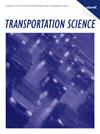Genetic Algorithms with Neural Cost Predictor for Solving Hierarchical Vehicle Routing Problems
IF 4.8
2区 工程技术
Q1 OPERATIONS RESEARCH & MANAGEMENT SCIENCE
引用次数: 0
Abstract
When vehicle routing decisions are intertwined with higher-level decisions, the resulting optimization problems pose significant challenges for computation. Examples are the multi-depot vehicle routing problem (MDVRP), where customers are assigned to depots before delivery, and the capacitated location routing problem (CLRP), where the locations of depots should be determined first. A simple and straightforward approach for such hierarchical problems would be to separate the higher-level decisions from the complicated vehicle routing decisions. For each higher-level decision candidate, we may evaluate the underlying vehicle routing problems to assess the candidate. As this approach requires solving vehicle routing problems multiple times, it has been regarded as impractical in most cases. We propose a novel deep learning-based approach called the genetic algorithm with neural cost predictor to tackle the challenge and simplify algorithm developments. For each higher-level decision candidate, we predict the objective function values of the underlying vehicle routing problems using a pretrained graph neural network without actually solving the routing problems. In particular, our proposed neural network learns the objective values of the HGS-CVRP open-source package that solves capacitated vehicle routing problems. Our numerical experiments show that this simplified approach is effective and efficient in generating high-quality solutions for both MDVRP and CLRP and that it has the potential to expedite algorithm developments for complicated hierarchical problems. We provide computational results evaluated in the standard benchmark instances used in the literature.History: This paper has been accepted for the Transportation Science Special Issue on TSL Conference 2023.Funding: This research was funded by the National Research Foundation of Korea [Grant RS-2023-00259550].Supplemental Material: The online appendix is available at https://doi.org/10.1287/trsc.2023.0369 .使用神经成本预测器的遗传算法解决分层车辆路由问题
当车辆路由决策与更高层次的决策交织在一起时,由此产生的优化问题会给计算带来巨大挑战。例如,在多仓库车辆路由问题(MDVRP)中,客户在交货前被分配到仓库,而在有容量的位置路由问题(CLRP)中,仓库的位置应首先确定。对于这类分层问题,一种简单直接的方法是将高层决策与复杂的车辆路由决策分开。对于每个高层决策候选方案,我们可以通过评估底层的车辆路线问题来对候选方案进行评估。由于这种方法需要多次解决车辆路由问题,因此在大多数情况下被认为是不切实际的。我们提出了一种基于深度学习的新方法,即带有神经成本预测器的遗传算法,以应对这一挑战并简化算法开发。对于每个高层决策候选方案,我们使用预训练的图神经网络预测底层车辆路由问题的目标函数值,而无需实际解决路由问题。特别是,我们提出的神经网络可以学习 HGS-CVRP 开源软件包的目标值,该软件包可以解决电容车辆路由问题。我们的数值实验表明,这种简化方法能有效生成 MDVRP 和 CLRP 的高质量解决方案,并有可能加快复杂层次问题的算法开发。我们提供了在文献中使用的标准基准实例中评估的计算结果:本文已被 2023 年 TSL 会议交通科学特刊接受:本研究由韩国国家研究基金会资助[RS-2023-00259550]:在线附录见 https://doi.org/10.1287/trsc.2023.0369 。
本文章由计算机程序翻译,如有差异,请以英文原文为准。
求助全文
约1分钟内获得全文
求助全文
来源期刊

Transportation Science
工程技术-运筹学与管理科学
CiteScore
8.30
自引率
10.90%
发文量
111
审稿时长
12 months
期刊介绍:
Transportation Science, published quarterly by INFORMS, is the flagship journal of the Transportation Science and Logistics Society of INFORMS. As the foremost scientific journal in the cross-disciplinary operational research field of transportation analysis, Transportation Science publishes high-quality original contributions and surveys on phenomena associated with all modes of transportation, present and prospective, including mainly all levels of planning, design, economic, operational, and social aspects. Transportation Science focuses primarily on fundamental theories, coupled with observational and experimental studies of transportation and logistics phenomena and processes, mathematical models, advanced methodologies and novel applications in transportation and logistics systems analysis, planning and design. The journal covers a broad range of topics that include vehicular and human traffic flow theories, models and their application to traffic operations and management, strategic, tactical, and operational planning of transportation and logistics systems; performance analysis methods and system design and optimization; theories and analysis methods for network and spatial activity interaction, equilibrium and dynamics; economics of transportation system supply and evaluation; methodologies for analysis of transportation user behavior and the demand for transportation and logistics services.
Transportation Science is international in scope, with editors from nations around the globe. The editorial board reflects the diverse interdisciplinary interests of the transportation science and logistics community, with members that hold primary affiliations in engineering (civil, industrial, and aeronautical), physics, economics, applied mathematics, and business.
 求助内容:
求助内容: 应助结果提醒方式:
应助结果提醒方式:


